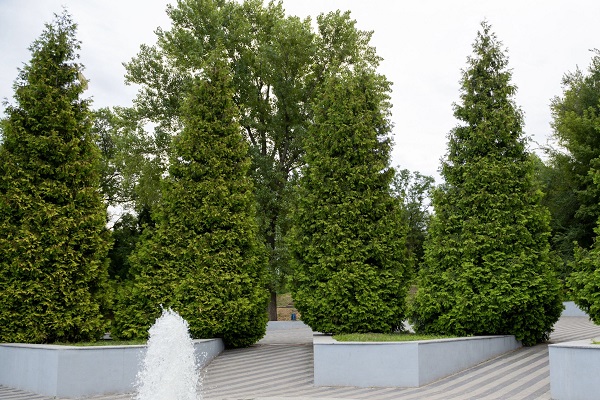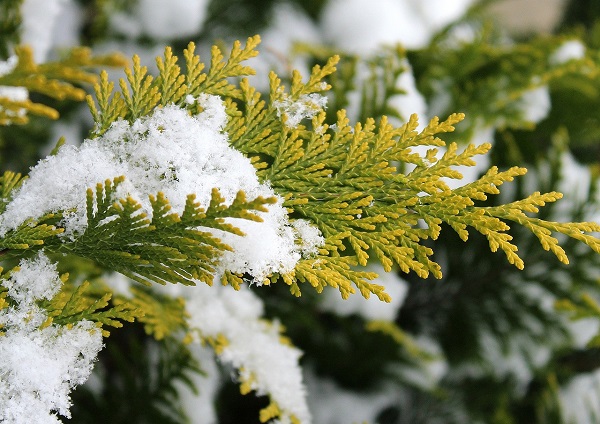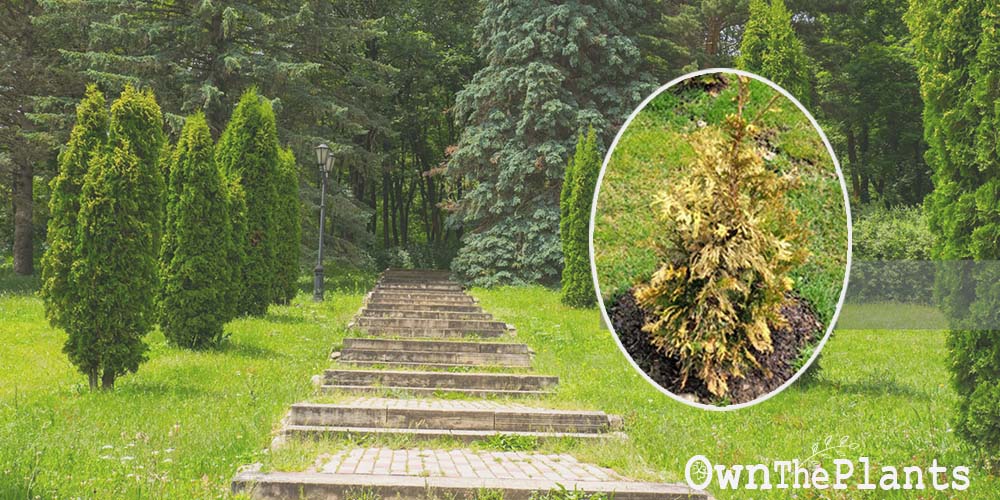The Arborvitae plant is among the most common evergreen trees used as windscreen or privacy hedges in gardens, yards, or any private spaces.
The lush, pyramidal canopy structure makes it an aesthetically pleasing landscape addition while still serving its intended function.
However, the green emerald Arborvitaes is very susceptible to plant issues. The most common problem of these plants is turning yellow, which surely can be a cause of concern.
The yellowing of Arborvitaes can be an anomaly sometimes but most often than not, they are caused by a more serious issue.
If you have noticed sudden discoloration of your Arborvitae, then you are on the right track.
In this article, we will tackle any possible cause of the yellowing of your plant, along with the necessary steps you need to take to resolve it.
We will also give you tips on how to avoid this problem again in the future.
Getting to Know Green Giant Arborvitae

The Green Giant Arborvitae is a large, fast-growing evergreen tree that can grow as much as 3 feet every year until it fully matures.
It is a hybrid of Thuja standishii and Thuja plicata. This plant is a conifer tree, belonging to the Cupressaceae family.
It boasts of its conical to pyramidal canopy form that is dense and verdant green. The foliage darkens or has a slight bronze tinge during the winter season.
This particular Arborvitae is a stellar landscape tree that functions well as a hedge or a privacy screen.
Plus, it is wind resistant once it is established and tolerates heavy icing or snowing. These characteristics of this plant makes it a perfect choice for natural windbreak.
Why Is My Green Giant Arborvitae Turning Yellow?
Arborvitaes shed leaves yearly even though they are considered evergreens. If in season, the yellowing and shedding of leaves should not be a primary concern.
However, when your plant does this out of season, this is considered an anomaly and is an indication of a more serious problem.
There are a lot of possible causes as to why your plant is becoming yellow and shedding leaves.
It could be a watering problem, temperature, nutrient deficiency, pests and fungal diseases, transplant shock, improper planting techniques, or animal damage.
Each of the possible causes mentioned has a specific fix so you really need to determine the underlying reason of your plant issue to resolve it.
Keep reading below as we delve right into these reasons one-by-one.
Watering Problem
Proper watering is crucial especially if your plant is still establishing. Your Arborvitae plant needs a lot of water as it is a fast-growing tree.
However, insufficient or excessive amounts can hinder its development and make it yellow.
Excessive Watering
To most plants, overwatering is the main cause of many problems, especially if the soil does not drain well and has a high tendency to be waterlogged.
When in waterlogged conditions, the roots get soaked and lose oxygen resources, hence becoming suffocated. This eventually lead to root rot and then death.
When your plant experiences root rot, it will not be able to absorb water and nutrients efficiently. It cannot function well and thus becomes weak and problematic. This mainly causes the yellowing of the leaves.
Underwatering
On the flip side, giving insufficient amounts of water to your plant can also cause stress. This stress manifests in the yellowing and browning of leaves.
Water is essential to plant metabolic processes, hence without it, your plant cannot basically function to live.
Watering Problem Fix
To fix the watering problem, rectify your watering routine at once. Before watering, check the topsoil first.
If it is still moist, then skip watering. Water only when the soil is already dry. This step is crucial since it will prevent you from giving excess water to your plant.
If the plant was underwatered, soak it with water first so that the soil will be moistened.
A soil that is left dry for a long period of time often repels water at first, so a thorough soaking is a must.
Nutrient Deficiency
Your Arborvitae plant requires additional minerals and nutrients to thrive, especially if it is in the same soil for a time.
The nutrients in the soil get depleted over time, hence you need to replenish it every now and then. Plant feeding is a must to ensure your plant grows and develops healthily.
Nutrient deficiency often manifests in chlorosis, or the yellowing of leaves, especially on the upper parts of the plant.
If the yellowing is concentrated on the upper region, then it is more likely that the cause is nutrient deficiency.
Nutrient Deficiency Fix
Feed your plant with balanced fertilizers, compost, or mulch. Any of these will give your plant enough boost to become healthy again.
Although fertilizers are the most complete type of plant feed since they contain nitrogen, zinc, iron, potassium, among others.
Regularly feed your plant at least once a month. Also, ensure the right soil pH is maintained.
The acidity of the soil affects how the plant absorbs the nutrients. If the soil pH is not at its optimum, the nutrients will just go to waste.
Temperature Problem

The Green Giant Arborvitae cultivar is supposed to maintain its green foliage all throughout the winter season, unlike other cultivars.
However, there are times that it can be quite sensitive to chilly weather. This manifests in yellowing or browning of the foliage.
The yellowing of the leaves, or foliage discoloration in general, can be more extreme if your plant is also exposed to severely windy spots.
Temperature Problem Fix
Since the Green Giant Arborvitae is a large tree, it is not practical to cover it to minimize the impact of temperature and wind.
However, you can just give it extra care for it to survive the winter season. Watering it before the ground is completely frozen can also help to prevent it from being dehydrated and experiencing water stress.
Pests
The Arborvitaes are somewhat resistant to pests, however, they can be occasionally infested especially if the environment encourages pests to thrive. This pest infestation led these trees to become yellow.
The common pest of Arborvitaes, the cypress tip miners, can cause yellowing discoloration of your plant.
The larvae of these miners consume the plant twigs and foliage and damage them. These damaged parts become yellow and eventually become dark during winter.
Pests Fix
Check for pests by shaking the branches. If you observe pests, prune and destroy infested parts to avoid spreading and kill eggs. You can spray pesticides on your plant and the plants nearby.
Alternatively, you may also use horticultural oils such as neem oils if you opt for a more organic solution.
Regularly spray pesticides on your plants at least once a month to ensure no pests will thrive and damage them.
It’s better to prevent them from feasting on your plant rather than getting rid of them.
Transplant Shock
If your plant is newly planted, you can expect adjustment stress to manifest in yellowing of leaves.
Your new plant is still dealing with environmental stress due to its new place, hence the yellowing or brownish of foliage is apparent.
Observe your plant. If you see only the inner regions are becoming yellow or brown, while the outer regions remain green, then you should not worry about it. Your plant is just undergoing a process and it will get better once it is finally adjusted.
Transplant Shock Fix
Take extra care of your plant while it is still adjusting and establishing itself. Allow it to root properly by watering it regularly.
Refrain from feeding it yet with fertilizer as it can cause chemical burns to newly forming roots.
Improper Planting Techniques
Wrong planting method of any plant, including Arborvitae, can cause yellowing of foliage. This happens when the plant is put too deeply into its soil mix.
When you make this wrong practice, it doesn’t allow proper aeration to the roots, leading to suffocation and death. New roots cannot form as well as it lacks oxygen resources.
Improper Planting Fix
The only way to fix this problem is to replant it properly. Redig your plant and plant it again.
You can do this even if months have already passed by. Plant it closer to the topsoil. The highest roots should be seen peeking on top of the soil.
Damage by Animals
If you have pets, animal damage can be causing the yellowing of your Arborvitae.
Dog pees can alter the nitrogen level of the soil, which ultimately affects the growth and development of your plant.
Observe and watch if your pets are urinating on or around your Arborvitae. Your pet’s urine can make your plant yellow and slowly turn it into brown when action is not taken.
Animal Damage Fix
This problem can be easily fixed by preventing your pets from urinating on the plant’s area.
You may put a fence or any barrier on your plant to isolate it from your pets. It is also best to prune the damaged foliage to encourage new growth.
Fungal Diseases
Aside from pests, fungal diseases can also cause your plant to become yellow.
Pestalotiopsis tip blight, most commonly known as black flagging, is just one of the common fungal diseases for Arborvitaes.
Blights can cause severe damage to your plant if not treated right away. It can also spread to other plants easily.
Fungal Diseases Fix
Like fixing your pest infestation problem, immediately isolate your plant, prune affected plant parts and properly throw it away to avoid spreading to other plants. Make sure you sterilize your cutting tool before and after using it.
After you prune your plant, spray fungicide on it and on nearby plants to ensure all of your plants are protected against possible fungal infections.
Do it on a regular basis. You may also opt to use neem oil if you want a more organic and natural solution.
Can A Brown Arborvitae Become Green Again?
Unfortunately, the browning of the leaves is irreversible. Once the leaf or the needles has become discolored, it will eventually die and shed.
However, this does not mean that your Arborvitae will be dead. Your plant can still be saved and can still produce green, healthy needles once immediate fix and care is given.
Final Thoughts
There is no other thing that can make plant owners happy but to have healthy, vigorously growing plants.
However, having a healthy plant is really a process. There are crucial steps that every plant owner must cautiously take to ensure the plants are thriving.
Your Arborvitae is a hardy plant that can tolerate a wide range of environmental conditions, yet it can still be affected and experience plant issues.
Now that you know why and what to do when you observe your plant turning yellow, surely, you are a better plant owner than before.
Share to us your experience on yellowing Arborvitaes and let the whole world know how you and your plant survived it. We would love to hear from you!
